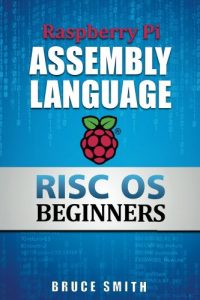This is a Hands-On-Guide to learning to program ARM assembly language on the Raspberry Pi using the RISC OS operating system. It is perfect for the novice with no prior knowledge of assembly language. It starts from first principles and leads you through new concepts using a modular approach with clear, lucid descriptions. Gradually progressing onto more complex topics you will become an accomplished and confident programmer by following the examples and applying them yourself.
The book shows how to use the inbuilt BBC BASIC Assembler to create and generate machine code and includes examples that demonstrate how to integrate the flexibility of BASIC into your assembler. Later chapters introduce the industry standard (and free) GCC Compiler and demonstrate how to create machine code and use its features.
From learning binary numbers, through to the use of logical instructions, this book continues right through to the use of floating point arithmetic, Thumb code and how to turn LEDs on and off using the GPIO interface. There is also a section of how to disassemble C programs to generate your own assembly language files.
This book was originally published under the title Raspberry Pi Assembly Language Beginners. It has been significantly revised and updated and renamed so as to distinguish it from its sister volume Raspberry Pi Assembly Language RASPBIAN Beginners. More details can be found at the author’s website: www.brucesmith.info
The book shows how to use the inbuilt BBC BASIC Assembler to create and generate machine code and includes examples that demonstrate how to integrate the flexibility of BASIC into your assembler. Later chapters introduce the industry standard (and free) GCC Compiler and demonstrate how to create machine code and use its features.
From learning binary numbers, through to the use of logical instructions, this book continues right through to the use of floating point arithmetic, Thumb code and how to turn LEDs on and off using the GPIO interface. There is also a section of how to disassemble C programs to generate your own assembly language files.
This book was originally published under the title Raspberry Pi Assembly Language Beginners. It has been significantly revised and updated and renamed so as to distinguish it from its sister volume Raspberry Pi Assembly Language RASPBIAN Beginners. More details can be found at the author’s website: www.brucesmith.info






